Picking the best aquarium filter can feel like a daunting task. If you have a smaller setup or one that requires extra care, consider trying out a sponge filter for aquarium.
This straightforward system uses an air pump, sponge, and tubing to pull in water, trapping dirt and fostering helpful bacteria.
Thus, get ready to dive into details of what is a sponge filter, how to install a sponge filter and how does sponge filter works!
Disclosure: This article contains affiliate links. When you follow a link to purchase the products, I sometimes earn a commission, at no additional cost to you. Read my full disclosure here.
What is an Aquarium Sponge Filter?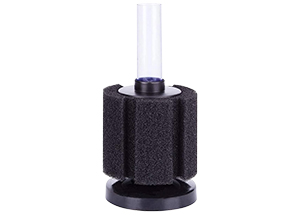
When a newbie aquarium hobbyist hears the word sponge filter, the first question that pops up in their mind is what is a sponge filter?
A sponge filter for aquarium is a simple device that utilizes a sponge and an air pump to effectively clean the aquarium by pulling water through the pores of the sponge.
While experienced hobbyists often favor this type of filter, newcomers may not be aware of its efficiency compared to more advanced filters.
Setting up sponge filter includes placing a sponge filter inside the tank, and connecting it with tubing to an air pump located outside. When the air pump pushes air through the tubes, bubbles are created which draw water through the sponge, mechanically eliminating debris and promoting healthy bacteria growth.
8 Reasons Why Setting Up Sponge Filters in Aquarium is Important?
Now, that you are clear about what is a sponge filter, you must be wondering how to install a sponge filter and how does sponge filter work. Right?
Well, before we take you through the details of how does sponge filter works, take a look at some reasons why setting up sponge filter in an aquarium is important;
Reason 1: Simple and Easy Design
Sponge filter for aquarium are basically just sponges housed in plastic. The bubbles generated by an air pump create a gentle flow, establishing a pathway for both mechanical and biological filtration.
Reason 2: Gentle Water Flow
Sponge filters are ideal for delicate environments such as fry or small organisms. Unlike more powerful filters, setting up sponge filter for aquarium is the best option for tanks that have spawners like Livebearers, as it prevents the fry from being suctioned into the filter.
Reason 3: Improved Filtration
Setting up sponge filter increases the effectiveness of filtration, which is particularly beneficial for tanks with many fish. Additional bacteria help break down ammonia and residual food more efficiently. Sponge filter for aquarium work well in conjunction with other types of filters.
Another advantage of using a sponge filter for aquarium in conjunction with other filters is that it allows for effective pre-filtration. By setting up sponge filter block over the intake of the canister filter, you can achieve mechanical filtration while still maintaining chemical filtration capabilities.
Reason 4: Noise Reduction
The noise level of a sponge filter for aquarium depends on the type of pump used. Nowadays, pumps are designed with rubberized seals to minimize noise. Though setting up sponge filter create some surface agitation, it is less harsh compared to other types of filters and can actually have a soothing effect.
Reason 5: Cost-Effective
Setting up sponge filters is a popular choice because they offer an affordable option for fish keepers. Unlike more intricate filters that require additional expenses for cartridges and media, sponge filter for aquarium consist of simple sponges and housing.
Reason 6: Flexibility
Sponge filters are suitable for different types of aquariums, including freshwater, saltwater, paludariums, and setups with live plants. If you have a larger tank, you may need a bigger sponge filter for aquarium.
Reason 7: Durable during Power Outages
Sponge filter for aquarium ensure that biological filtration remains intact even when there is a power outage. This helps to prevent the bacteria from dying off. Although water circulation stops during this time, the sponge still continues to break down waste material.
Reason 8: Convenient Maintenance
If you want to live carefree then setting up sponge filter can offer you a hassle-free cleaning process. Simply remove any debris by brushing it off and then gently squeeze the sponge in aquarium water to maintain the bacterial colony. Cleaning every 3 weeks to 1 month is adequate for them.
How to Install a Sponge Filter?
If you are seeking how to install a sponge filter in aquarium, then let us tell you that it’s not as complicated as it sounds.
Just read the steps written below thoroughly and you will be all set for how to install a sponge filter!
Set up the components
- Remove the molded strainer from the foam by disassembling the sponge filter.
- Position the air stone at the bottom of the strainer after removing the bullseye from it.
- A brief section of airline tubing is used to link the air stone and the bullseye. Link the air stone straight to the bullseye for small filters.
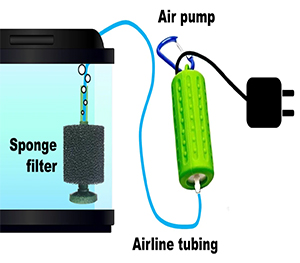
Arrange the Strainer
- Reattach the bullseye to the strainer’s top with a snap.
- Reintroduce the strainer into the foam.
- Connect the strainer to the sponge filter’s weighted base.
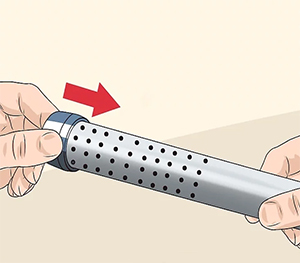
Attach lift tube
- Overlap a portion of the airline’s tubing roll with the lift tube.
- The bullseye’s top nipple serves as the connection point for the airline tubing’s other end.
- Attach Bullseye with the lift tube
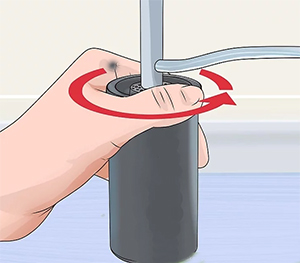
Place sponge filter
- Place the sponge filter for aquarium in the tank and, if the foam is floating, remove any bubbles from it.
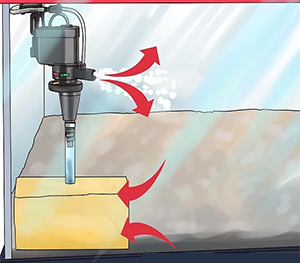
Setting up the Air Pump
- Outside the tank, set up the air pump.
- To ensure that the airline tubing roll reaches the air pump, cut it to the proper length (it is linked to the sponge filter).
- From the sponge filter to the air pump, connect the new air tubing.
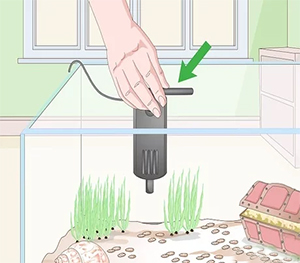
Insert a check valve
- To stop water from back flowing, add a check valve if the air pump’s height is below the top of the aquarium.
- With the flapper assembly facing the air pump, cut the airline tubing just a few inches outside the tank, then fasten the check valve. Water cannot enter the airline tubing because of this.
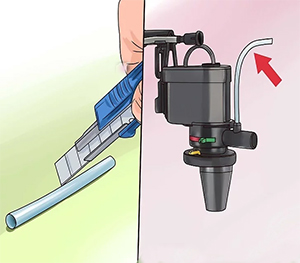
Confirm secure setup
- The air pump’s power cable should be bent into a drip loop to keep moisture from getting to the plug.
- Connect the air compressor.
- Observe result.
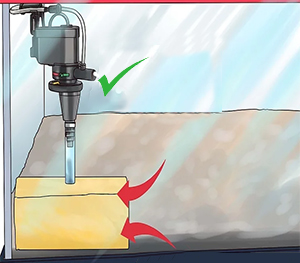
How Does Sponge Filter Work?
Sponge filters are popular among both new and experienced aquarium lovers. This is how does sponge filter works;
Mechanical Filtration
To maximize their efficiency, sponge filters for aquarium should be used in conjunction with an air pump or powerhead. Air pumps generate bubbles that pass water through the sponge, capturing debris in the strainer. Powerheads force water through the sponge before entering the system, guaranteeing comprehensive filtration for pristine water quality.
Biological Filtration
Sponge filters primarily work by filtering out particles, but they also serve as a habitat for bacteria. The sponge’s unique structure promotes the growth of beneficial bacteria, which then break down pollutants in the water and improve its quality.
Downsides of Sponge Filter for Aquarium
Setting up sponge filter is great for removing debris and promoting bacterial growth, but they can’t remove chemicals since they don’t use chemical media.
Some experts believe that with effective mechanical and biological filtration, the need for chemical filtration is reduced.
Another downside is their appearance. The bulky sponge can take away from the overall visual appeal of the aquarium.
However, with careful planning during setup, especially in tanks with lots of plants, it’s possible to minimize the noticeable effect of a sponge filter on the aesthetics.
Sponge Filter Maintenance
- To prevent clogging and keep the filtration at its best, make sure to regularly clean the sponge filter for aquarium.
- Take out the filter from the tank and gently squeeze it into a container of old tank water to get rid of any debris.
- Remember not to rinse it with tap water since chlorine and chloramines can harm beneficial bacteria.
- Once cleaned, put the filter back into the tank to maintain the uninterrupted growth of bacteria and optimal performance of your filtration system.
1. UPETTOOLS Aquarium Biochemical Sponge Filter
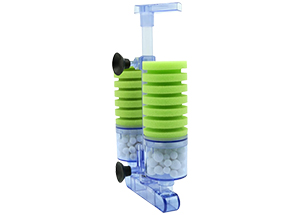 Quick view on Amazon
Quick view on Amazon
Available in: Australia, Canada, UK and US
2. Lefunpets Sponge Filter

Quick view on Amazon
Available in: Australia, Canada, UK and US
3. AQUANEAT 4 Pack Double Bio Sponge Filter
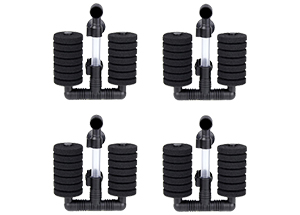
Quick view on Amazon
Available in: Australia, Canada, UK and US
Conclusion
Many beginners tend to underestimate the usefulness of setting up sponge filter for aquarium because they have some misconceptions about them.
However, when used correctly, these filters can provide effective filtration just like other systems. They are particularly suitable for delicate creatures, tanks with low binloads or smaller sizes, and tight budgets.
So, if you know any aquarium enthusiasts, let them know what is a sponge filter, how to install sponge filter and why every tank needs it! It’s worth recognizing the potential benefits that come with using sponge filters in your aquarium setup.



